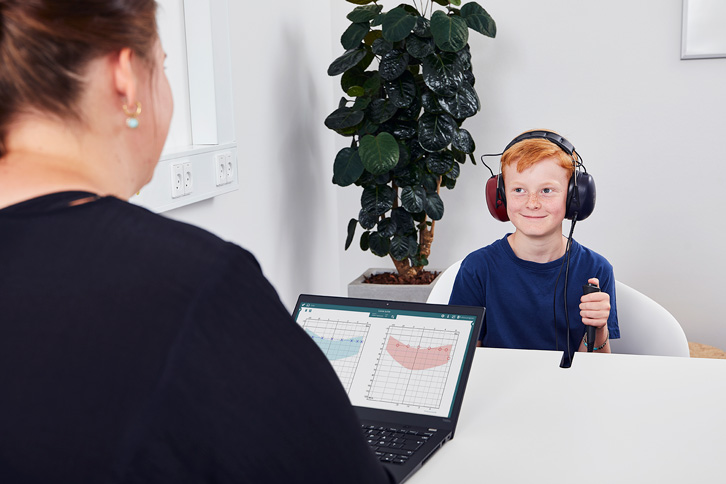Training in Advanced Tests
Automated Audiometry and the Changing Role of the Audiologist
Description
Table of contents
- What is automated audiometry?
- Which test methods can you apply for automated audiometry?
- Which transducers can you use for automated audiometry?
- How to perform automated audiometry
- What are the benefits of automated audiometry?
- Automated audiometry vs manual audiometry
What is automated audiometry?
Automated audiometry is a computer-led method of performing audiometric threshold acquisition. As the method of finding a patient’s hearing threshold is procedural and follows a general flow, its logic can be automated.
Automated audiometry has been in the literature for many years, first described by Hughson and Westlake [1] in 1944 and by Békésy [2] in 1947.
These two methods provide an automated audiogram. This is achieved by presenting tones to the patient and the computer looks for a response which is indicated by the patient pushing the response button. These tests are well established in the literature and are still in use today. We find that these techniques are mainly used across the following areas:
- Occupational health screening
- Cochlear and retrocochlear testing
- Military hearing testing
- School screening
1. Occupational health screening
Occupational health screening is used in locations where workers are exposed to high levels of background noise. Hearing thresholds are measured over time to see if the noise in the workplace is having an impact on the workers’ hearing levels.
2. Cochlear and retrocochlear testing
Although many tests exist to differentiate between cochlear and neural hearing losses, the Békésy test is still used for cochlear and retrocochlear testing to identify the location of pathology.
3. Military hearing testing
We also see automated testing used in the military, where personnel are exposed to significant noise. This follows the same principles as occupational hearing screening but is done in a different setting. The results can be used to determine if military personnel are fit to work operationally. Having access to automated audiometry in this situation reduces the need for skilled, first-line testers.
4. School screening
Lastly, we see this technology being used in school screening settings. As children get older, the prevalence of hearing loss increases. Therefore, school screening is still a common method for identifying those who have acquired hearing loss between the newborn hearing screening – which occurred at birth – and school age.
The Luna audiometer is an example of an audiometer which offers an automated method for school screening purposes, as well as occupational health screening and military hearing testing (Figure 1).

Which test methods can you apply for automated audiometry?
Automated audiometry has historically been related to unmasked air conduction testing only. Some screening audiometers are also able to perform unmasked bone conduction.
With technological advancements in this area nowadays, masked threshold acquisition and even speech audiometry (through selection of a forced-choice response) can be performed using automated audiometry. This has recently been demonstrated through IA-AMTAS, which is available with the Affinity Compact.
This allows for a complete, diagnostic hearing assessment to be performed with minimal clinician interaction. As the process is automated, this allows for consistency across organizations who cover a wide geographical area to standardize their practice while maintaining their high level of diagnostics.
When considering the topic of automated audiometry, it is important to note that the methods used to acquire the hearing thresholds are robust and evidence based. Scientific articles supporting the IA-AMTAS method can be found at the end of this article [3] [4].
Which transducers can you use for automated audiometry?
You can use all the same transducers used in manual audiometry for automated audiometry. This includes supra-aural headphones, insert earphones, and bone vibrators. This ensures that it fulfils the same standards and can be recognized as equal to manual audiometry.
The only variation shown in automated audiometry is that in IA-AMTAS, you apply the bone vibrator for bone conduction testing with a forehead montage instead of a mastoid montage. This is purely different for speed so that you can apply all relevant transducers at the start of the test before knowing which ear is better/worse.
The effect of the forehead location has been researched and reported in the scientific literature to have minimal effect on hearing thresholds. You can still compare thresholds from this different montage to the mastoid montage using correction factors [3].
How to perform automated audiometry
In the video below, you can see the steps required to perform automated audiometry – using IA-AMTAS in this example – including patient instructions and transducer placements.
What are the benefits of automated audiometry?
Let’s have a look at some of the core areas where we can see automated audiometry having an advantage in the clinic:
- Consistency
- Clinic efficiency
- Use in satellite clinics
- Reduced contact audiology
- Use in teleaudiology
- Reducing waiting lists
- Converting walk-in clients
1. Consistency
Automation standardizes audiometric procedures, which allows consistency in testing. It does this by accounting for patient inconsistencies and tester inconsistencies.
Patient inconsistencies
With IA-AMTAS, a series of quality indicators are used to ensure that when there are inconsistencies in the responses recorded from the patient, these are flagged in the system and reported to the clinician interpreting the test. A traffic light system is used to determine the quality of the test and whether the test should be repeated.
Tester inconsistencies
Despite national and international guidelines being available for audiometry, testing techniques between testers using manual audiometry still differs significantly. The automated method provides consistency using an algorithm based on best practices. It uses no sound trials and irregular stimulus presentations to mimic the gold standard test techniques used in manual audiometry.
2. Clinic efficiency
By employing automated audiometry in the clinic, this will allow clinical staff to perform other tasks while the client is undertaking audiometry, such as:
- Clean the client’s hearing aid(s)
- Look at the results of the questionnaires
- Evaluate on an appropriate amplification strategy
This will free up time to increase clinical capacity or to spend more time on the interpersonal aspects of the appointment, such as counseling the client.
3. Use in satellite clinics
Satellite clinics are becoming increasingly more common in the world of audiology. Here we see a hub clinic, usually based in a busy location, with spokes located in less busy or more graphically difficult places to reach.
These satellite clinics are not always staffed and can be a problem when reliant on a clinician being present to perform manual audiometry. This becomes less of an issue when clients can complete an automated hearing test without the presence of a trained audiologist. It’s important to note that a trained professional is required to place on the transducers.
The results from such an automated test can then be shared with the trained hearing care professional in the hub. When the audiologist and the client then meet, the audiologist will already have a full automated hearing test and be able to make use of that time to make decisions about amplification or rehabilitation choices.
4. Reduced contact audiology
The COVID-19 pandemic has had an impact on the way that we work and one of the benefits of automated audiometry is that the automation process provides less physical contact with the patient.
The tester is only required to put the transducers on once whereas in traditional audiometry, the tester would be touching the patient multiple times when moving between air conduction, bone conduction, and masking.
Also, while the patient is undergoing the automated audiometry task, the tester can technically be outside of the room.
These two components reduce exposure risk which is particularly important during pandemics or with vulnerable patients.
5. Use in teleaudiology
We are seeing a huge amount of change in our profession in this area. Automation is at the heart of teleaudiology, which will allow increased clinical capacity and a full, on-demand service via telehealth methods to be achieved. Expect to see more changes in this area as telehealth is implemented across clinics globally.
6. Reducing waiting lists
There’s always a problem with maintaining the fine balance of reducing the length of the waiting list while maintaining clinical quality. With automated audiometry, it is possible to have a single audiologist running diagnostic testing for multiple patients in multiple sound booths.
By doing so, it is possible to streamline staffing resources so that the diagnostics are still completed fully and accurately, but then weight the staffing on tasks where automation is not yet established such as in the hearing aid fitting process.
In general, automation allows for more creative thinking within the audiology clinic without compromising the quality of the care provided.
7. Converting walk-in clients
Walk-ins are unscheduled visits from potential clients and are very valuable for private businesses. The challenge with walk-ins is that the clinician will often be busy seeing their full list of clients and not have time to give the walk-in patient any attention. Therefore, it can result in the walk-in patient leaving the clinic and not coming back.
With automated audiometry, we are in a situation where clinics can provide walk-in patients with an automated hearing test. They can undergo the procedure and have the results delivered to the audiologist where the client can then meet with the audiologist and discuss the next steps.
Hopefully, this will result in an increase in conversions for walk-in patients and a reduction in loss of business for them not returning.
Automated audiometry vs manual audiometry
So, if automated audiometry is so good then why do we still need manual audiometry?
There could be several reasons:
- Local legislation
- Reimbursement and clinician liability
- Complex cases where advanced testing is required
- Further assessment required if the quality of the automated method is reported as poor
One major concern which clinicians sometimes express with automated tests is the role of the audiologist being diminished. What we’re going through at the minute is an evolution in our clinical practice where the role of the audiologist is changing. Despite access to new tools, the dialog between the audiologist and the person with the hearing impairment is always going to be essential.
So, despite these tools being present, we shouldn’t be afraid that they’re going to be taking away the role of the audiologist. Rather, we should embrace the tools and look at how they can make our lives easier so that we can then impact the lives of our patients in a better way, be that through counseling or by doing more advanced testing.
Conclusion
The quality of automated audiometry is improving, and it could one day become the standard method of audiometry for the routine or non-medical patients.
Alongside other tools, automated audiometry will change the role of the audiologist but the need for audiologists will never diminish, rather the contrary.
References
[1] Hughson, W., Westlake, H. D., & American Academy of Ophthalmology and Otolaryngology. (1944). Manual for program outline for rehabilitation of aural casualties both military and civilian: Sponsored by the American Academy of Ophthalmology and Otolaryngology. Omaha, Neb: Douglas Print. Co.
[2] Georg v. Békésy (1947) A New Audiometer, Acta Oto-Laryngologica, 35:5-6, 411-422, DOI: 10.3109/00016484709123756.
[3] Margolis, R. H., Glasberg, B. R., Creeke, S., & Moore, B. C. (2010). AMTAS: automated method for testing auditory sensitivity: validation studies. International journal of audiology, 49(3), 185–194.
[4] Eikelboom, R. H., Swanepoel, deW., Motakef, S., & Upson, G. S. (2013). Clinical validation of the AMTAS automated audiometer. International journal of audiology, 52(5), 342–349.
Presenter

